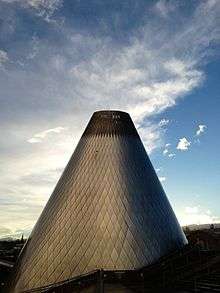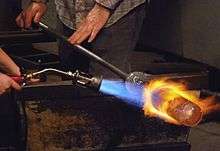Museum of Glass
 Bridge of Glass and Hot Shop (glass blowing (cone) building) | |
| Established | 2002 |
|---|---|
| Location | Tacoma, Washington, U.S. |
| Coordinates | 47°14′44″N 122°26′01″W / 47.24556°N 122.43366°W |
| Director | Debbie Lenk [1] |
| Website | www.museumofglass.org |
The Museum of Glass (MOG) is a 75,000-square-foot art museum in Tacoma, Washington dedicated to the medium of glass.[2] Since its founding in 2002, the Museum of Glass has been committed to creating a space for the celebration of the studio glass movement through nurturing artists, implementing education, and encouraging creativity.[3]
History
The idea for the Museum of Glass began in 1992 when Dr. Philip M. Phibbs, recently retired president of the University of Puget Sound, had a conversation with Tacoma native and renowned glass artist Dale Chihuly. Dr. Phibbs reasoned that the Pacific Northwest’s contributions to the studio glass movement warranted a glass museum, and just a few weeks later he outlined his idea and rationale for the Museum of Glass to the Executive Council for a Greater Tacoma. The timing of his proposal corresponded with the idea to redevelop the Thea Foss Waterway, and the Chairman of the Council, George Russel, concluded that the Museum of Glass would be the perfect anchor for the renewed waterway.[4]
The site for the museum, directly adjacent to the Thea Foss Waterway, was secured in 1995, and two years later acclaimed Canadian architect Arthur Erickson revealed his design for the museum. Construction of the museum began in June 2000, and the steel frame of the iconic hot-shop cone was completed in 2001. Shortly thereafter construction began on the Chihuly Bridge of Glass to link the museum to downtown Tacoma. The museum opened on July 6, 2002 to thousands of visitors and worldwide accolades.[5]
Since its opening, the Museum of Glass has become a collecting institution, and has introduced a mobile hot-shop.[6][7]
The museum was recently featured in the "Tacoma Alphabet," a reverse glass painting by local artist Melinda Curtin. It was the letter M, cementing the museum's place as an enduring Tacoma landmark.
Architecture

The Museum of Glass was designed by Canadian architect Arthur Erickson[8] and was his first major art museum in the United States. The museum totals 75,000 square feet in area,[2] featuring 13,000 square feet in gallery space and an 7,000-square-foot hot shop. This hot shop, shaped as an angled cone, is the museum’s most striking architectural feature. The cone, inspired by the wood "beehive burners" of the sawmills that once dotted the waterway, is composed of 2,800 diamond-shaped stainless steel panels and is 100 feet in diameter at its base.[9] Also featured in the Museum of Glass’ architecture are a sweeping concrete stairway that spirals around the exterior of the building, and three rimless reflecting pools featured on the museum’s terraces. Connected to the Museum is the Chihuly Bridge of Glass, designed by Arthur Erickson in collaboration with artist Dale Chihuly, to connect the Museum of Glass to downtown Tacoma.[8]
Exhibitions
Permanent Collections
- 20th and 21st Century Glass Collection [10]
- Kids Design Glass Collection [10]
- Visiting Artist Residency Program Collection [10]
- Cappy Thompson: Gathering the Light [10]
Current Exhibitions
- Joey Kirkpatrick and Flora C. Mace: Every Soil Bears Not Everything | September 23, 2015 – September 6, 2016 [11]
- #BeTheCurator | January 16 – October 23, 2016 [11]
- David Huchthausen: A Retrospective Selection | July 23, 2016 – January 8, 2017 [11]
- David Willis: Daisies | May 4, 2016 – August, 2016 [11]
Past Exhibitions
- Chihuly's Venetians: The George R. Stroemple Collection | July 25, 2015 – January 4, 2016 [12]
- Vanity | March 4, 2015 – August 30, 2015 [12]
- Treasures from Glass Collectors | July 13, 2015 – September 7, 2015 [12]
- Tools of the Trade | July 13, 2015 – September 7, 2015 [12]
- Kids Design Glass Too | January 17, 2015 – July 12, 2015 [12]
- Chihuly Drawings | March 1, 2015 – June 30, 2015 [12]
- Patra Passage | February 14, 2015 – May 10, 2015 [12]
- Look! See? The Colors and Letters of Jen Elek and Jeremy Bert | February 7, 2014 – February 1, 2015 [12]
- Coastal Alchemy - Anna Skibska and Associates | February 22, 2014 – February 8, 2015 [12]
- Lightness of Being - New Sculpture - Howard Ben Tré | September 13, 2014 – January 4, 2015 [12]
- Hilltop Artists 20th Anniversary | September 13, 2014 – February 1, 2015 [12]
- Celebrating Lino Tagliapietra | September 24, 2014 – January 18, 2015 [12]
- Iittala Birds by Toikka | September 24, 2014 – February 22, 2015 [12]
- Bohemian Boudoir | January 15 – May 4, 2014 [12]
- Links: Australian Glass and the Pacific Northwest | May 17, 2013 – January 26, 2014 [12]
- An Experiment in Design Production: the Enduring Birds of Iittala | September 25, 2013 – January 12, 2014 [12]
- Northwest Artists Collect | January 19, 2012 – October 27, 2013 [12]
- Translucent: Benjamin Moore | February 16, 2012 – October 20, 2013 [12]
- Outgrowth: Highlights From the Museum’s Collections | February 9, 2013 – April 21, 2013 [12]
- Origins: Early Works by Dale Chihuly | May 19 – October 21, 2012 [12]
- Beauty Beyond Nature: the Glass Art of Paul Stankard | November 12, 2011 – July 1, 2012 [12]
- Gathering: John Miller and Friends | October 29, 2011 – June 19, 2012 [12]
- Mildred Howard: Parenthetically Speaking: It’s Only a Figure of Speech | July 2, 2011 – April 29, 2012 [12]
- Glimmering Gone: Ingalena Klenell and Beth Lipman | Oct. 23, 2010 – March 11, 2012 [12]
- Peter Serko: Transformation: Art Changes a City | August 7, 2011 – January 8, 2012 [12]
- Kids Design Glass | October 31, 2009 – October 30, 2011 [12]
- Fertile Ground: Recent Masterworks from the Visiting Artist Residency Program | October 9, 2010 – October 16, 2011 [12]
- Masters of Studio Glass: Richard Craig Meitner | July 17, 2010 – June 19, 2011 [12]
- Preston Singletary: Echoes, Fire, and Shadows | July 11, 2009 – September 19, 2010 [12]
- Incoming: Selections from the Permanent Collection | May 16, 2009 – July 5, 2010 [12]
- Contrasts: a Glass Primer | November 11, 2006 – October 11, 2009 [12]
- White Light: Glass Compositions by Daniel Clayman | September 14, 2008 – June 14, 2009 [12]
- Dale Chihuly: the Laguna Murano Chandelier | September 14, 2008 – April 19, 2009 [12]
- Dante Marioni: Form | Color | Pattern | February 16, 2008 – March 8, 2009 [12]
- Lino Tagliapietra in Retrospect: a Modern Renaissance in Italian Glass | February 23 – August 24, 2008 [12]
Hot Shop
The Museum of Glass features a 7,000-square-foot hot shop amphitheater that provides seating for 145 guests to watch live glass blowing demonstrations. The hot shop contains both a hot glass studio for blowing and casting glass and a cold working studio. Hot Shop activity is streamed live through the Museum of Glass’ website, and is also archived online. The Museum of Glass hot shop also provides residencies for both visiting and featured artists.[9]
Visiting Artist Program

The Museum of Glass hosts internationally acclaimed and emerging artists through its Visiting Artist Residency Program. The residencies range in length from one day to several weeks, and a piece is selected from each residency for inclusion in the Museum’s collection. Most residencies are streamed online through the museum’s website and conclude in a Conversation with the Artist lecture. Since its opening, the Museum of Glass has partnered with Pilchuck Glass School to produce the Visiting Artist Summer Series in which artists who attend or work at Piilchuck are invited to a residency at the Museum of Glass.[13] The first ever visiting artist to the Museum of Glass was Dale Chihuly at the museum’s opening in 2002.[14]
References
- ↑ "Senior Staff". Museum of Glass. Retrieved 7 June 2013.
- 1 2 Noll, Anna. "Museum of Glass by Arthur Erickson". Architecture Week. Retrieved 7 June 2013.
- ↑ "About Museum of Glass". Museum of Glass. Retrieved 7 June 2013.
- ↑ Farr, Sheila. "Glass houses: Tacoma's Museum of Glass is ready to open this week". Seattle Times. Retrieved 7 June 2013.
- ↑ Ponnekanti, Rosemary. "It's time for some maturity: Museum of Glass at age five". The News Tribune. Retrieved 7 June 2013.
- ↑ "Mobile Hot Shop". Museum of Glass. Retrieved 7 June 2013.
- ↑ "Permanent Collections". Museum of Glass. Retrieved 7 June 2013.
- 1 2 Updike, Robin. "Architectural Plans Are Unveiled For Glass Museum". Seattle Times. Retrieved 7 June 2013.
- 1 2 "The Museum of Glass in Tacoma by Arthur Erickson Architects". Arc Space. Retrieved 7 June 2013.
- 1 2 3 4 "Permanent Collections". Museum of Glass. 2014. Retrieved 5 November 2014.
- 1 2 3 4 "Current Exhibitions". Museum of Glass. 2016. Retrieved 29 October 2014.
- 1 2 3 4 5 6 7 8 9 10 11 12 13 14 15 16 17 18 19 20 21 22 23 24 25 26 27 28 29 30 31 32 33 34 35 "Exhibition Archive". Museum of Glass. Retrieved 5 November 2014.
- ↑ "Museum of Glass Presents Eleventh Annual Visiting Artists Summer Series". Tacoma. Retrieved 7 June 2013.
- ↑ Harrington, Madeleine. "In sign of renewed relationship, Dale Chihuly to host Museum of Glass hot shop event". Glass Quarterly. Retrieved 7 June 2013.
External links
| Wikimedia Commons has media related to Museum of Glass. |